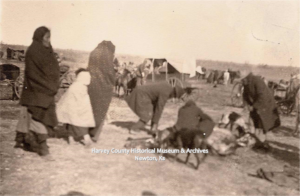by Kristine Schmucker, Archivist/Curator
In a letter written to a ladies committee, Dr. Gaston Boyd shared one story about an interaction with Native American people traveling through the area around Newton in 1871. Dr. Gaston Boyd arrived in Newton, Ks April 10, 1871. He was very involved in the early establishment of Newton and Harvey County.
He wrote this story in response to an unknown ladies group. Boyd’s letter to them gives a small glimpse into the life of Native Americans in Harvey County before their removal in 1873.
According to Boyd, a group of Native Americans, including women and children, were traveling to the Osage Reservation near Council Grove. Along the way they would hunt buffalo, found primarily around Burrton and Hutchinson. This was not an unusual occurrence.
They traveled through the area “with their ponies dragging their tents and other luggage hitched to poles, the back end of which were (sic) dragging on the ground.”
Dr. Boyd recalled one particular incident. They had camped on Sand Creek, just north of Newton. The women remained in the camp, but the men “invaded the town principally on the hunt for fire-water. Several of them got gloriously drunk, so much so that the ones who remained sober became quite anxious to get them out of town.”
One of the drunk men “got ugly and abusive.” When the men got back to camp, “the women*** pounced upon him with clubs and beat him to death. When they broke camp the dead Indian was fastened to the back of a pony and taken, it was supposed to the Indian burying ground.”
Boyd explains that no one interfered. Henry Mayer, the City Marshall, made no arrests “and no special excitement was in evidence over the occurrence.”
***”women” is used in place of the offensive term in the original document.
Sources
- Boyd, Dr. Gaston to the ladies of the Committee. Letter, 26 July 1911, Newton, Ks. Copy of letter at the Harvey County Historical Museum & Archives, Curator Files, Boyd, Dr. Gaston.
About the Photo
The photo was likely taken in Indian Territory around 1900. The scene seems to be a distribution of food and other supplies.

